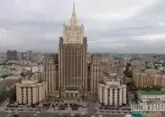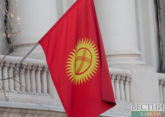A conflict broke out on the border of Tajikistan and Kyrgyzstan shortly before the informal summit of heads of Central Asian states. This is the most serious confrontation of the neighboring republics' residents over the past five years. It was reported that two people were killed and a few dozen injured as a result of being hit by stones. A government commission has been created to investigate the causes of the collision. The reason, meanwhile, is on the surface - this section of Tajik-Kyrgyz border is not demarcated or at least delimited.
It has been said that when the time comes for practical work on delimitation, it is possible that these works will have to be carried out under the protection of CSTO troops or UN blue helmets to avoid collisions. As for the option of exchanging territories, such discussions alone can cause a political crisis in Kyrgyzstan.
President of Tajikistan Emomalii Rahmon and President of Kyrgyzstan Sooronbay Jeenbekov announced that they are taking control of the border situation and agreed to set up a joint commission to investigate and prevent such incidents in the future. An agreement was also reached on intensifying negotiations on delimitation.
It's not the first time when the presidents agree on this issue. In February last year, they discussed the cross-border problem during official talks in Dushanbe. However, despite the presidents' statements about their intention to resolve the issue, the delimitation and demarcation of the border's disputed parts have not been started. The total length of the border between Kyrgyzstan and Tajikistan is 976 km, of which only 504 km have been delimited and demarcated. The remaining parts are considered controversial.
The construction of a road in the Batken region has caused the current aggravation. Deputy Prime Minister of Kyrgyzstan Jenish Razakov and Deputy Prime Minister of Tajikistan Azim Ibrohim left for the border. They agreed to establish a group of police officers to patrol the border area 24 hours a day. A closed meeting was held the Kyrgyz parliament on the situation in the border area.
Kyrgyz political analyst Denis Berdakov visited the scene and shared his observations with Vestnik Kavkaza:
- The Fergana Valley is an intermontane area in the territory of Uzbekistan, Tajikistan and Kyrgyzstan with the highest population density in Central Asia. In Soviet times, local residents did not attach much importance to who lives where. However, after the USSR collapsed, the situation has changed radically. Not only independent countries were formed, but also enclaves. The borders of three countries - Kyrgyzstan, Tajikistan and Uzbekstan - converge in the Batken region.
- Conflicts are usually accompanied by a difficult socio-economic situation. What about this in the current conflict area?
- The conflict occurred in Tajikistan's Vorukh exclave, where about 35 thousand people live on 130 square kilometers. Over the past 18 years, the number of people living there has increased 30 times. The neighboring village of Aksai belongs to Kyrgyzstan. And then comes the Tajik territory of Chorku, which divides the Batken region into two parts. The border there is not demarcated or delimited. Understanding that neither side will make concessions in determining the border, Kyrgyzstan has begun the construction of the Koktash-Ak-Sai-Tamdyk bypass road in 2013. There is one more road since Soviet times, but the problem is that it is located on the territory, which is claimed by both Tajikistan and Kyrgyzstan. Therefore, Kyrgyzstan decided to build its own road on the territory, which Tajikistan has never claimed. Tajikistan initially agreed that Kyrgyzstan builds a road on its territory and connects the two parts of the region. Thus, the construction was started in 2013 in Batken and brought to the Aksai-Vorukh disputed section. But in 2014 the troubles have started. The new road is not profitable primarily for Vorukh - it loses its trade advantages.
- That is, the conflict is provoked by the Tajik side?
- More often, yes. Tajikistan cannot ban the construction of a road, but is trying to hinder it in some way. The Tajik side mainly starts protests. But the Kirghiz are also ready to fight for every piece of land. Therefore, the situation is always tense.
- How to solve the conflict? Is there a way out?
- The situation is really difficult. The border in this area is not delimited. Both sides favor demarcation. An attempt was made last year by President Sooronbay Jeenbekov. But the principle of "to get something, you must give something away" does not work here.
- The land is not suitable for living. Is it logical to sacrifice some pieces of rocky terrain, but not to risk people's lives?
- After Bishkek transferred the land to China, the situation developed in a way that if the authorities sign a document on the transfer of even one hectare of land, but receive five times as much in return, they will become 'national traitors'. Therefore, the Kyrgyz authorities will only compromise if the border is fully delimited.
- There were also difficulties with Uzbekistan, but the situation was resolved.
- It was easy to sign an agreement on the border with Tashkent, because it was delimited by 70%. There are no mountains, no controversial sites. But the situation with the remaining 30% is difficult. It will be easier if Kyrgyzstan builds a road. It will receive the "connected" Batken region and then the intensity of the dialogue with Tajikistan will be defused.

Despite the fact that the situation has been stabilized, in fact, it is a vicious circle - as soon as the construction of the road resumes, protests by Tajikistan will be also resumed. But if they do not build a road - half of the Batken region will remain cut off. Political analyst Arkady Dubnov believes that the conflict on the border poses serious problems for the summit to be held on April 12 in Tashkent - a meeting of the heads of the five Central Asian states, whose goal is to create a certain community of Central Asian countries united by common values.
"Of course, there was a serious provocation, which threatens aspirations of the leaders of the five states to define and realize their goals. I think that if Rakhmon and Jeenbekov meet personally in Vorukh or Aksai before April 12, this meeting would be effective. They would demonstrate to the local residents that the two countries cannot fight each other. They must restore peace, solve the problem of border delimitation in a short time, perhaps with mutual territorial concessions and exchanges," Dubnov said in an interview with Azatlyk radio.
A version of the Tajik side was presented by the press center of the head department of the border guards of the State Security Committee of Tajikistan: "On March 13, the construction of the Koktash-Aksay road was started in violation of the bilateral intergovernmental protocol on the territory of the jamoat (district - VK) Tamdyk. Residents of the Vorukh jamoat of the city of Isfara protested against these actions of Kyrgyzstan. In response, the Kyrgyz opened gunfire at the residents of the named jamoat," the official statement reads. Two dead and dozens of wounded were reported.
In addition, the Kyrgyz blocked the Isfara-Vorukh road and took hostage passengers of local minibuses and car owners - from 30 to 60 people, according to various sources. All of them are kept at the Kyrgyz border.
The conflict spread to the neighboring village of Khojai Alo. A resident of the village, a Tajik teacher of the village school Hakim Huseynov was killed by a hunting rifle. Four more people were injured.
"At the initiative of Kyrgyzstan, a commission was established to investigate the causes of the conflict. A preliminary investigation was conducted. One person was injured in the chest. Another 10 people received injuries of varying severity from stones. All this information is documented and provided to the Tajik side. The Tajik side hasn't provided its documents, but reported one victim," Denis Berdakov said. - In 2014, when the Tajik side used a mortar, the defense ministers of the two countries intervened. Then an agreement on the non-use of weapons was reached. The situation threatened to escalate into ethnic conflict. This time, Kyrgyzstan is acting as openly as possible in investigating the incident."
It is possible that when they start to demarcate the border, they will have to deploy UN troops. Otherwise, conflict cannot be avoided. As for the option of exchanging territories, it will instantly cause a political crisis in Kyrgyzstan.










